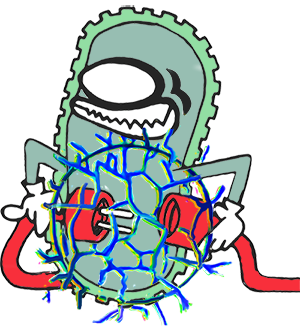Team:TU Delft-Leiden/Project/Life science/landmine/integration
From 2014.igem.org
Integration of Departments
- Module Landmine Detection
- Context
- Integration of Departments
- Cloning
- Characterization
Described are the general why and how of the practices Modeling as well as Microfluidics with respect to experimental work performed in the Module Landmine Detection. Escherichia coli is the model organism in which a system was implemented that is able to trigger a reaction in and of this organism to the presence of compounds leaching from landmines. Escherichia coli carries promoters of genes hypothesized to respond to compounds containing nitrogen. DNT, TNT and DBP contain this element and leach from landmines. By coupling of fluorescent molecule mKATE2 to (improved versions of) these promoters, qualification of the response and hence of the presence of the compound is possible. This module thus encompasses the development of a biosensor.
Modeling and Experimental Work point to E.coli responding to N-containing compounds
Modeled has been the responses of Escherichia coli to compounds DNT, TNT and DNB in a straightforward fashion, see Modeling: Landmine Module. Input were compounds, generated was the response of the promoter. Exploratory data points integrated in and to which the model was fit where taken from Belkin et al., whose research triggered the team to work with these specific promoters in the first place. Results pointed to a response of the promoters to compounds DNT, TNT and DNB. Furthermore, data points were generated from imaging of mKATE2 fluorescence and linking fluorescence to compounds added at defined points in time after induction with relevant compounds. Intriguing black box in this Module remains the influence of regulatory enzymes, possibly nitrogen-linked, and genes encoding these elements. Experimental work thus centered not only on responsive promoters and compounds, but, in addition, response depending on several enzymes functional in nitrogen metabolism in order to shine light on the black box regarding the reaction and actual molecular basis of reaction to compounds leeching from landmines.
In-field measurements of response of E.coli via Microfluidics
Implementation of a system of microfluidics within this Module is based on the aspiration to be able to perform in-field measurements of compounds leaching from landmines. Details on construction of an in-field measurement system can be found under Gadget. The necessity of having this type of device points to the use of microfluidics. Aspects central in development of this type of device are, amongst others, the speed of reaction, the possibility of in vivo measurements at all points in time and options for quantification. Aim, construction and functionality of what is hereafter referred to as the mothermachine are discussed under Microfluidics: MotherMachine. This type of microfluidic system is intended for single-cell experiments, utilizing nanoscale channels coupled to a central channel for flow of media. Team iGEM 2014 TU Delft has made use of the standard model previously utilized in various studies [.]. In general terms, the device is constructed via a positive silicon waver coupled to a plastic mold. The team has constructed its negative with PDMS, generating channels. Size of channels and size of cells should be taken in consideration, the latter partly depending on growth conditions. Holes and tubes coupled to these holes, coupled to the central channel deal with flushing with medium, with respect to the Module Landmine Detection carrying compounds DNT, TNT or DNB. Before application, the PDMS sample is connected to a glass slide by oxygen plasma and prepared for action by consecutive flushing with, amongst others, BSA. More information regarding the design and construction of the mothermachine can be found in the section Microfluidics: MotherMachine.
 "
"






